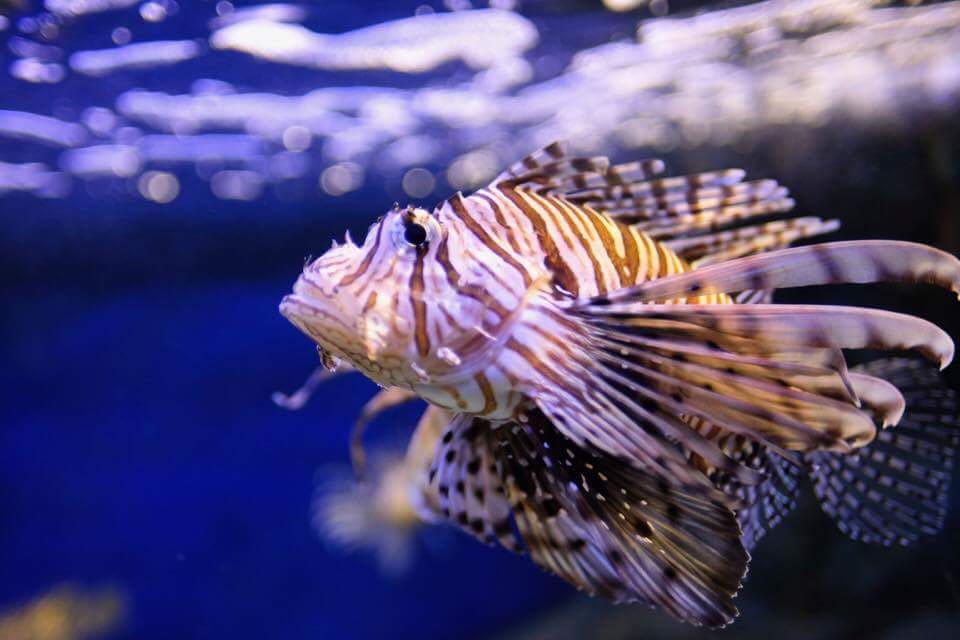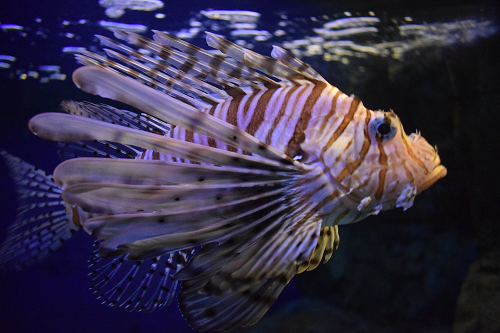
With a “mane” of spines protruding from around its body, it’s clear where the mighty lionfish (Pterois volitans) gets its name. Formidable yet beautiful, this striking tropical fish is a star attraction here at Bristol Aquarium.
Native to the coral reef systems of the Indo-Pacific Ocean, lionfish are among the most successful predators within these unique marine habitats. That’s all thanks to their highly venomous spines, so potent the animal has few natural predators in the wild.
Due to their dazzling appearance, lionfish are a hugely popular aquarium fish, captivating visitors with their impressive appendages and distinct colouration. Here at Bristol, you can see these wonderful fish in Coral Seas – our centrepiece display housing over 250 unique marine species.
For now, why not get to know the mighty lionfish a little better with our essential guide?
Lionfish Characteristics
Whichever way you look at them, it’s clear that the lionfish is no ordinary fish! Everything about them screams “danger”, from the white, red and brown stripes encircling their bodies, to the huge dorsal spines that run from their heads to their tails. Trust us – these aren’t fish to be messed with.
Adult lionfish can grow up to 45cm in length but appear much larger due to their long spines, tentacle-like appendages, and blade-like fins. They use all of these oversized body parts to help them navigate slowly through coral reef systems, with the ability to turn sharply this way and that to trap prey or evade ambitious predators.
And as if they weren’t formidable enough, lionfish are also highly venomous. Their dorsal spines deliver a painful sting that is fatal to most predators, hence why – like their namesake – they’re top of the food chain and the undisputed “kings of the jungle”.
Lionfish Habitat
From Australia to Malaysia, Japan to New Zealand, lionfish have a huge native range that stretches across much of the tropical zone of the Indo-Pacific Ocean. Here, they reside mainly in coral reef systems at a depth of 1-300 feet, but can also adapt to other habitats including mangroves, seagrass, shipwrecks and hard-bottom seabeds.
What’s important to note about lionfish is that they’re now considered a non-native invasive species in some seas and oceans around the world, including the Atlantic. Here, these fearsome fish are causing ecological chaos, with no natural predators to control their numbers. In the Caribbean Sea and the Florida Keys, in particular, lionfish are having an untold impact on native habitats and species, with several initiatives in place to bring their numbers under control.
How did lionfish reach the Atlantic and other non-native seas around the world (including the Mediterranean)? That’s easy: they came from aquariums. It’s thought that irresponsible home aquarists are to blame for lionfish becoming an invasive species in so many habitats across the globe, with animals dumped into the sea with no thought for the implications this could bring.
What Do Lionfish Eat?
Lionfish are carnivorous fish who actively hunt their prey, using their long appendages and quick-turning ability to trap unfortunate victims. Although they’re highly visible and slow-moving, lionfish are considered top predators in their preferred coral habitats, thanks in part to the relentless way they pursue and corner their prey.
Due to their large head and mouths, lionfish are capable of eating surprisingly large fish, including juvenile snappers and groupers. Up to 50 species are on the menu for lionfish, making them one of the reef’s most prolific predators – not to mention one of its least choosy.
Typically, lionfish tend to hunt nocturnally, as their bright, conspicuous appearance would make it nigh-on impossible to do so during the day. They have a tendency to prey on “algae-eaters” – ecologically invaluable fish that consume algae off coral reef systems. This is a particular problem in environments where lionfish are considered invasive.
Fun Facts About the Mighty Lionfish
Keen to know more about the unique and fearsome lionfish? Here are some fascinating facts you should know…
- Lionfish have an average of 18 venomous spines on their bodies. 13 of these are found on the dorsal (upper) side of the fish, two are found on the pelvis, and a further three are located on the fish’s anal fin.
- Female lionfish lay up to TWO MILLION eggs each year. That’s a lot of baby lionfish! Females are thought to release between 10,000-30,000 eggs every four days.
- Lionfish swallow their prey whole. Yep, the grim reality for any fish trapped by a lion is that there’s no real means of escape. After cornering their prey with their long appendages, lionfish lunge forward and swallow their lunch in a single bite. Gulps!
Where Can You See Lionfish at Bristol Aquarium?
The red lionfish is one of over 250 tropical species on display at the Coral Seas exhibit here at Bristol Aquarium. The focal point of our aquarium, this massive 250,000-litre tank offers a colourful showcase of rare and exotic marine animals, complete with an underwater tunnel for an up-close perspective of these astonishing creatures.
Alongside lionfish, you can expect to see some incredible reef-dwelling animals at Coral Seas, from the adorable clownfish (Amphiprioninae) to cownose rays (Rhinoptera bonasus) and the inimitable giant grouper (Epinephelus lanceolatus).
Ready to experience an up-close encounter with the beautiful lionfish? Plan your visit and book your tickets today.
Type
Fish
What do they eat?
Fish and Invertebrates
Size
30cm
Water Type
Tropical Marine
Where are we?
Indo-Pacific Ocean
See Us At
Coral Seas
